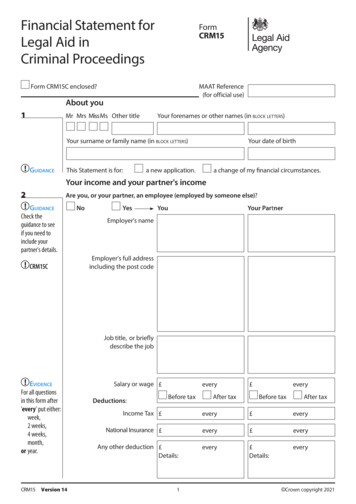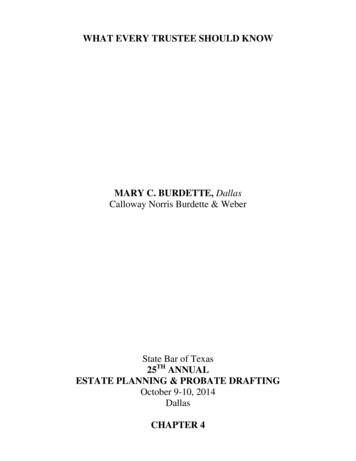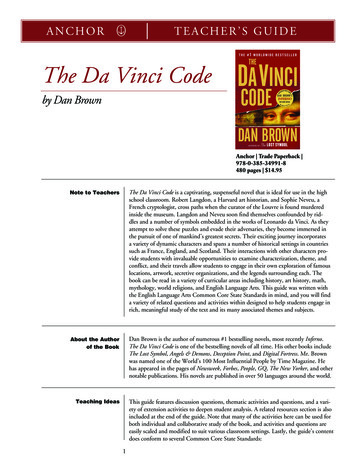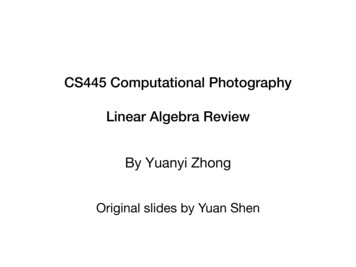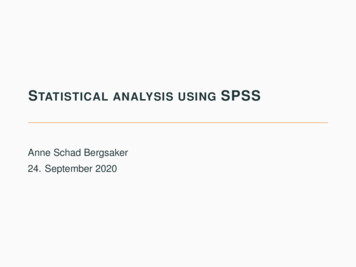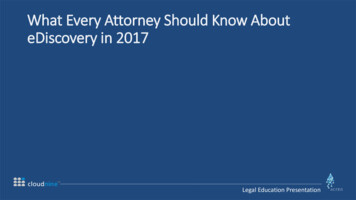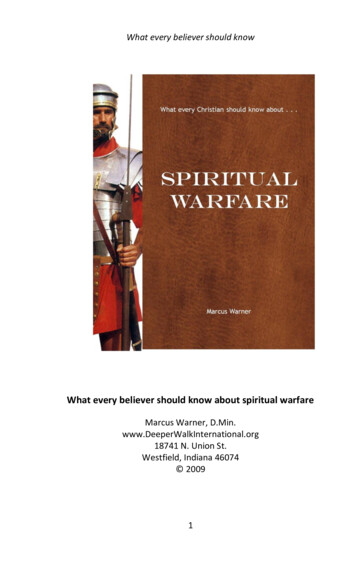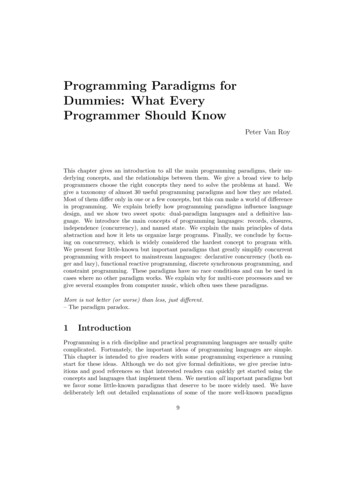
Transcription
UNCLASSIFIEDEvery Cryptologist ShouldKnow about Pearl HarborTOM JOHNSONThe surprise Japanese attack on Pearl Harbor in 1941 was an event of surpassingimportance in American history. But beyond that, it was the most important event ofAmerican cryptologic history. As cryptologists we should study Pearl Harbor for itsimpact on our profession. This impact is felt in two ways.a. It has influenced how the American public views our profession. This has beeninfluenced, in turn, by the winds of political change.b. It surfaced a number of debates within the Federal Government about the place ofcryptology and the methodology of intelligence analysis. We are still debating the issuesthat it raised.The story of Pearl Harbor began like a mystery novel. How had the diminutiveJapanese, growers of rice and practitioners of bushido, caught us off guard? By the timePresident Roosevelt went before Congress on 8 December to denounce the "day that willlive in infamy" a stunned American public had already begun to ask the question; "Howdid they catch us with our pants down, Mr. President?"How had they, indeed? To find out, Roosevelt promptly dispatched Secretary of theNavy Frank Knox to Honolulu. Knox returned on 14 December - something of a recordconsidering the transit time required for a trip to Hawaii and back in those days - toreport to Roosevelt on the devastation. In all, 2,403 men lost their lives and the backboneof the Pacific Fleet was at the bottom of the harbor. Morale, he reported, was terrible, andthe commanders on the scene, Admiral Kimmel for the Navy and General Short for theArmy, appeared shattered.It had long been customary for military commanders to assume full responsibility forthe performance of all people and operations under their command. The unit that ranaway or the vessel that plowed into a wharf earned the commander summary relief. Itcame as no surprise to the American public, then, that Knox's return coincided with thedismissal of both Kimmel and Short from their positions. At the same time, Rooseveltannounced the appointment of a commission of five distinguished Americans, headed bySupreme Court Justice Owen Roberts, to investigate the disaster and recommendremedial steps. Roberts and his commission flew to Hawaii and held a series of secrethearings. Kimmel and Short, along with a group of other officials involved, wereinterviewed. The proceedings were, by all contemporary accounts, extremely brief andexceedingly hostile to the two commanders in the field. There appears to have been noreal attempt to explore the nuances of a military failure, only to find and identify ascapegoat for the American public. The idea was to get on with the war as quickly aspossible and to spend as little time as was necessary putting Pearl Harbor behind us, touse the parlance of the 1970s. After spending a little time in Washington getting thestory from administration figures such as Secretary of War Henry Stimson and SecretaryKnox, the Roberts Commission released its report to the President. The two commandersin the field should bear direct and personal responsibility for the failure, but officials inWashington should be exonerated. They shared none of the blame.55UNCLASSIFIED
UNCLASSIFIEDCRYPTOLOGIC QUARTERLYThat was on 23 January 1942, only a month after Knox had returned from Hawaii.The administration was clearly proceeding with a good deal of haste to identify theculprits. On 28 February Knox and Stimson issued statements accepting the retirementsof Kimmel and Short. A statement of charges was being prepared concerning derelictionof duty, which would later be adjudicated in a courts martial. The trial would proceed,however, "only at such a time as the public interest and safety would permit."Meanwhile, the two former commanders would have to wait their turn. This, theadministration hoped, would silence dispute over the causes of the surprise.To understand why it did not, one must turn to domestic politics. Roosevelt had beenPresident since 1932. Although his success in domestic economy had caused a veritablepolitical revolution and given him an overwhelming political majority, he had arouseddiametrically opposed conservative views, and the passionate arguments had raged eversince his first election. These passions were immediately transferred to the Pearl Harborcontroversy. Journalists on the political right pilloried the administration for beingunprepared. In the days fol lowing the attack very few were listening, but as the war woreon and success became more certain, more energy was expended on the Pearl Harbordispute. Each writer had his point of view, and it almost invariably reflected his politicalpersuasion rather than a dispassionate analysis of the facts.The first book-length explanation of what happened at Pearl Harbor was written by apair of journalists closely connected to the Democratic Party, Forrest Davis and Ernest K.Lindley, who wrote How the War Came in 1942. Davis and Lindley could be considered"court historians" in the sense that they accepted the administration's word for thingswithout too much digging. Two years later a politico named John T. Flynn, a longtimeRoosevelt-hater, came out with The Roosevelt Myth, which hypothesized that our entryinto the war was a result of Depression economics and Roosevelt's calculated attempt toend the Depression by egging Japan into war. Here was the first suggestion thatRoosevelt himself played a hand in the attack by deliberately pushing Japan into acorner . According to Flynn, he had been toJd in 1938 by one of Roosevelt's "most intimateadvisors" that the President would push Japan into a war so that he could fire upAmerican heavy industry to build battleships. This, said Flynn, was the President's wayof edging out of the Depression, and it had worked.By Federal law, Kimmel and Short had to be tried within two years of their allegeddereliction. This term expired in December 1943. Congress extended it for six monthsand again for another six months when that period expired, but in so doing, directed theWar and Navy departments to conduct internal investigations concerning the Japaneseattack and the performance of the two commanders in the field. Conducting theinvestigations in secret, both boards took hundreds of hours of testimony from virtuallyeveryone involved and had access to extremely sensitive documents regardingintelligence and operational matters. It was far more thorough and more objective thanthe Roberts panel. Both boards turned in reports highly critical of War and Navydepartment officials in Washington and singled out both George C. Marshall, Chairmanof the Joint Chiefs of Staff, and Harold Stark, Chief of Naval Operations, for criticism.But the reports were classified, and in lieu of releasing their contents, an embarrassedStimson and Knox issued brief press statements instead. They concluded that, thoughKimmel and Stark shared much of the blame for unreadiness at Pearl Harbor, there hadbeen incompetence galore, and it would be wrong to force them to shoulder the entireblame. Relief from duty was sufficient punishment, without going through the ignominyof a public trial. Their retirements stood unchanged.This did not quiet the demand for public disclosure. What objection, Americanswanted to know, could there possibly be to releasing in entirety a report dealing with anissue that had occurred three years earlier? Surely the needs of military secrecy had beenUNCLASSIFIED56
WHAT EVERY CRYPTOLOGIST SHOULD KNOWUNCLASSIFIEDmet long ago. Now it just so happened that controversy over the Army and Navy boardsoccurred in the middle of the 1944 Presidential election. The Republicans were havingdifficulty finding an issue that would convince the public to evict a President in themiddle of a world war. Surprise at Pearl Harbor was one of their few useful weapons.Republican congressmen began raising the cry of cover-up. Hugh Scott, a senator fromPennsylvania, claimed to know that the Australian Government had warned theadministration on 6 December but had been ignored. Ralph Church, a representativefrom [l)inois, introduced the name of Alwin Kramer, a Ne.vy lieutenant commander who,Church said, had delivered messages to the State Department the evening of 6 Decemberand the morning of7 December, which the administration was covering up.By the summer of 1944 there was clearly a certain amount of scuttlebutt on theWashington scene that the Administration had known about the attack in advance andwas trying to cover this up. The story had something to do with breaking Japanese codesand related to a nocturnal mission by Kramer to deliver decoded Japanese dispatches tothe President. Republican Presidential candidate Thomas Dewey had the informationbut was dissuaded from using it during the campaign by an emissary sent by GeneralMarshall himself.Reelection of Roosevelt did not end the clamor. Vociferous Republican demands for acongressional investigation increased, and finally, on 6 September 1945, DemocraticSenator Alben Barkley of Kentucky issued a call for a joint investigation of Pearl Harbor.Four Democrats and four Republicans joined Barkley on the committee of nine. Rooseveltwas now dead, and the Truman administration made a calculated decision to release allthe classified documents so long under wraps. The Japanese diplomatic code had beenbroken; key administration officials had been aware of the lowering diplomatic clouds;certain warnings had been passed to Hawaii. Many of the key documents, including thenow-famous 14-part Japanese message ending negotiations and breaking relations, werereleased in entirety. All important figures, less Roosevelt and Knox, who were dead, andStimson, too ill to be present, were interrogated. So at last the secret was out, fair gamefor politicians, journalists, and historians.And they had a field day. Within a year of the investigation's conclusion the firsthistory was out. Written by George Morgenstern (a Chicago Tribune journalist), PearlHarbor: The Story of the Secret War attacked the Roosevelt administration formishandling the negotiations with Japan and for gross dereliction in failing to warn thecommanders in the field of the impending storm. The next year Charles Beard, one of themost famous historians in America, claimed that Roosevelt had lured Japan into firingthe first shot in a war he knew was inevitable. Beard pointed out that this was anunconstitutional aggrandisement of executive power. Congress alone was empowered todeclare war and should not be maneuvered into one by events controlled by the President.A whole school, called "revisionism," grew up around the Pearl Harbor hearings. Theleading revisionist was Charles Tansill, chairman of the history department atGeorgetown University. In Back Door to War (1953) he propounded a conspiracy theory,which went much farther than Morgenstern's. Incompetence was too mild a term - therehad been something sinister in Roosevelt's studied lack of attention to the warningsconveyed in the coded Japanese messages. Why, after reading the first 13 parts of thefinal message late on the evening of 6 December, did not Roosevelt immediately call ameeting of his key military advisors? (The National Security Council was not set up until1947 .) To quote an incensed Tansill,57UNCLASSIFIED
UNCLASSIFIEDCRYPTOLOGIC QUARTERLYThe tutimony of General Marshall and Admiral Starlr; would indica that the Chief l!::s:eeutive tookthe ominous news ao calmly that he made no effort to conault with them. Did he deliberately seelt thePearl Harbor attack in order to get America into the war? . This problem growa more complicated a.awe watch the approach of zero hour. At 9:00 A.M. OD 7 ember, Lieutenant Commander Kramerdelivered to Admiral Stark the final installment of the Japanese inatl'action to Nomura . But hemade no effort to contact Honolulu. IDBtead be tried to get in touch with General Marshal, who, foraome strange reason, suddenly decided to go oD a long horseback ride . Wa& there an importantpurpose to this ride? (pp. 651-52)Tansil! had concocted a "devil theory": Roosevelt deliberately withheld information fromHawaii to insure that the attack would lead to war. He wanted war, wrote Tansill, toprotect the British Empire, which had been the primary aim of American foreign policysince 1900. To insure this, he had to enlist Marshall, Stark, Stimson, Knox and others ina conspiracy of silence. No longer did historians have to content themselves withdiplomatic failure and military incompetence-Tansill had found outright conspiracy.Tansill was regarded in historical circles as part of a "radical fringe"; most accountswere more conventional. Historians like Walter Millis (This is Pearl, 1947), Herbert Feis(The Road to Pearl Harbor, 1950), and Langer and Gleason (The Challenge to Isolation,1952,and The Undeclared War, 1953) pointed to an aggressive Japanese militaryexpansion and intractable diplomatic posture as the real causes. These accounts focusedon the broader issues of diplomatic positioning and the problems of dealing with fascismand simply dismissed the conspiracy theory as incredible and mean-spirited.A revisionist high-water mark of sorts was achieved in 1953 with the publication ofPerpetual War for Perpetual Peace by Harry Elmer Barnes. Barnes's purpose was toprovide a publication opportunity for his revisionist colleagues, including William HenryChamberlin (America's Second Crusade, 1950), Frederick Sanborn (Design for War: 'AStudy of Secret Power Politics, 1937-1941, 1951), Tansill, Morgenstern, and others.Barnes saw conspiracy everywhere. There was a conspiracy to cover up Pearl Harbor.There was a conspiracy to cover up the cover-up. There was a conspiracy to halt·publication of revisionist tracts. Not content to contest the opposing theories on the basisof historical fact, Barnes resorted to name-calling, terming his historical opposition"hatchet men" and their reviews ofrevisionist writings "smears."To understand the psychology of revisionism one must look at the political climate ofthe late forties and early fifties. After the war there was a pronounced swing to thepolitical right. Truman's political upset of Dewey in 1948 increased the demands for anend to the Democratic control of the Presidency. This period coincided with the rise of JoeMcCarthy, the trial of Alger Hiss, the loss of atomic supremacy to the Russians, and thefall of China to the Communists. The Korean War intensified the debate over . who lostChina" and whether or not the State Department was shot through with Communistsympathizers and outright traitors. In this climate the revisionists came to represent thepolitical far right, an academic equivalent of McCarthyism. Proponents of the acceptedhistorical view on Pearl Harbor were, in many cases, associated politically with theadministration. Herbert Feis was an economics adviser to the Department of State;Robert Sherwood (Roosevelt and Hoplt.ins, 1948) worked as a speech writer for Roosevelt;both Langer and Gleason had held advisory positions within the Roosevelt administrationduring the war. Some, like Sherwood and Ernest K. Lindley, had made use of their closepersonal association with the President to obtain access to documents that had not yetbeen released to the public. The revisionists were just as clearly among the political"outs" and did not have equal access to these private collections. Academically they were"vitriolic and angry men" who heaped scorn on the so-called "court historians" who usedtheir place at the political table to obtain unique materials. (Robert H. Ferrell, "PearlHarbor and the Revisionists," The Historian, Spring 1955.)U NCLASSI Fl ED58
WHAT EVERY CRYPTOLOGIST SHOULD KNOWUNCLASSIFIEDThe far right began losing its influence in the early days of the Eisenhow radministration, and McCarthy died in 1957 a thoroughly discredited man. At the sametime the academic debate over revisionism faded after the publication of Barnes's book.The argument was temporarily revived in 1955 by the publication of Admiral Kimmel'smemoirs (Admiral Kimmel's Story), which took the administration to task forwithholding information from the commanders at Pearl Harbor. Kimmel also accusedRoosevelt of withholding critical military resources that would have permitted anadequate defense of Hawaii. The Democrats were thus guilty of military ineptitude andincompetence which virtually guaranteed that a Japanese attack would succeed.On the whole, however, the late fifties and early sixties slipped by uneventfully. Itwas a time for summing up, and summaries were unkind to the revisionist school. HansTrefousse, Robert Ferrell, and Wayne Cole, all renowned for their historical judgments,concluded that there was no substance to revisionism. Ferrell offered the most accuratejudgment when he cited bad analysis, not conspiracy: "The real tragedy of the Magicepisode is that this magnificent information on Japanese intentions and diplomaticmaneuvering was not properly evaluated in the War and Navy departments; everybody'sbusiness (the intercepts went to the top officials of the government and military) becamenobody's business, and the careful evaluation of the decoded intercepts was neveraccomplished." Finally, in 1962, a new book by Roberta Wohlstetter seemed to put thematter to rest forever (Wohlstetter, Pearl Harbor: Warning and Decision). Her thesis wasthat there had been too much information, not too little, and that the nuggets were buriedin what she called the "noise." This was hailed as a brilliant explanation of events, andWohlstetter has since been used as a consultant by successive governments on theproblem of indications and warning.Revisionists and establishment historians continued to snipe, but the dispute seemedbasicalJy over. Then in 1977 the American and British governments declassified andreleased much of their World War II Sigint archives. Over the next several years millionsof pages of selected wartime Sigint documents were declassified and released to theNational Archives in Washington and the Public Records Office in London. Historianswent scrambling for the information, and a new wave of Pearl Harbor accounts hit thebookstores. The first significant addition was British historian John Costello's ThePacific War(l981).Costello subjected the Sigint messages to detailed examination. His conclusionsappeared at first glance to differ little from previous scholarship. Kimmel was not,indeed, getting vital information. Stark decided not to give him Magic because there hadbeen a scare in the spring of 1941 occasioned by a warning passed to the Japanese by theGermans that their diplomatic circuits were not secure. The Japanese apparently ignoredthe warning, but the War and Navy departments did not. They tightened security andreduced dissemination; from then on Kimmel received only vague summaries penned byAdmiral Stark himself. But Magic contained no military information. Much moreimportant was traffic from the consular code, JN-19, which contained information ofcounterespionage value. Intense Japanese interest in Pearl Harbor was reflected in codeddispatches, which were either ignored (because of supposed low value) or simply notpassed on. Costello became tremendously impressed with the volume of Sigint and thusbuttressed Wohlstetter's noise thesis. "It is now easy to see how the principal cause of thebreakdown in American military intelligence during the period before Pearl Harbor wasthat it was grossly overloaded and unable to carry out an adequate evaluation procedure"(p. 609).But Costello's central thesis was revisionist. After examining the evidence he decidedthat there must be more. Speculating on what "more" there might be, he propounded arather elaborate theory that the British had broken the Japanese fleet operational code,59UNCLASSIFIED
UNCLASSIFIEDCRYPTOLOGIC QUARTERLYcalled by the American cryptologists JN-25, and were privy to Japanese intentions, eventhough the American Navy had not yet broken it. (He also not.ed with interest that theU.S. had given the British a Purple analog machine, used to decipher Magic traffic, andspeculated that they might have had more Magic decrypts than we did.) He went on tohypothesize that Churchill may have either passed a warning to Roosevelt on 26November, in which case the Americans would be culpable for the disaster, or withheld itto insure the United States would enter the war, in which case Churchill would be thevillain. He pointed out that the British had yet to release Sigint for the period leading upto the attack and felt there was something fishy.A year later an American, John Toland, published Infamy: Pearl Harbor and ItsAftermath (1982). This totally revisionist book examined all the alleged warnings andcredited every one. Agent warnings about a Japanese attack on Pearl Harbor appeared todeluge the Roosevelt administration. These would now be called Humint, andauthenticating this information was as difficult then as it is now. Some now appear tohave been genuine - for instance, the information provided by double agent Dusko Popov,the infamous "Tricycle" to whom J. Edgar Hoover refused to listen. Information waspassed through Koreans, Peruvians, Dutch, British - any nation and every nation. Mostof this was rather low quality stuff, if it was not in fact a figment of some ne's forty-yearold imagination. Where Toland made his headlines, however, was a story straight out ofSigint - the famous Seaman Z story.Seaman Z was a young Naval reservist working in the 12th Naval DistrictHeadquarters in San Francisco in 1941. Sometime in November his supervisor told himto plot some mysterious DF fixes alleged to be a Japanese fleet somewhere in the northernPacific. A few days later Pearl Harbor was bombed, and for the first time young "Z" madea connection between the air raid and the transmissions. He assumed that the vessels hadbeen the carrier strike force, and that the information had surely been reported promptlyto President Roosevelt. He remained silent about the incident until Admiral Kimmel'sson convinced him, many years later, to talk to Toland about it.The information caused a sensation in historical circles, and Seaman Z was promptlyunmasked as one Robert Ogg, then a retired California businessman. He submitted to amore detailed and searching interview with cryptologic experts from the Naval SecurityGroup Headquarters and did not come out quite so well. He did not know where the fixescame from. (It was probably a Federal Communications Commission operation.) He onlyassumed that he was following a Japanese carrier task force but had no technical basis forthis and did not inquire as to how his supervisors had identified the transmissions asJapanese. When questioned, he hadn't the foggiest idea how one went about making suchan identification. There was not a shred of evidence that cryptologic professionals in OP20-G (NSG's predecessor) so identified this traffic. For all the amateurs in the 12th NavalDistrict knew, the signals could have emanated from a Liberian freighter, a commercialfishing fleet, or an off-course Lebanese taxi cab. As for the idea that Ogg's commander,Captain McCullough, was a personal friend of Roosevelt's and would surely have passedthis information on to the White House, research into administration r ords and files inthe Roosevelt Library revealed no such connection between the two. And even if the twohad been acquainted, the Navy had not yet arrived at the point where an obscureintelligence officer in a Naval geographic command could pick up the phone and call theWhite House. The technical weaknesses of Toland's Seaman Z story were exposed by theNSG interview, and the entire episode was reduced to smoldering ruins in an article byTelford Taylor, who had been chief of the American-British cryptologic liaison office inLondon during the war. ("Days of Infamy, Decades of Doubt," New Yorlt Times Magazine,29 April 1984.)UNCLASSIFIED60
WHAT EVERY CRYPTOLOGIST SHOULD KNOWUNCLASSIFIEDAccording to Toland, other Sigint-based warnings came from the Dutch, who hadbroken Japanese consular codes and had information about Japanese attacks on Hawaii,Philippines, Malaya, and Thailand. (This was entirely possible since the consular codeswere known to be vulnerable, and some of the messages did carry information of thistype.) Still another warning came from the British, who on 6 December warned theAmerican observer in Cairo, Colonel Bonner Fellers, of an impending Japanese attack onthe U.S. within 24 hours. (Fellers did not forward the information.) Here was anotherallegation of British foreknowledge of the sort propounded by CostelJo the year before.Toland also rehashed the infamous Winds Execute controversy which had played sucha prominent role in the l945 Pearl Harbor Hearings. The Winds Code ("East Wind Rain")was clearly set up by the Japanese as an insurance policy to get a war message through toits embassies and consulates at the last moment should there be no secure means ofcommunication. But that was the last thing any two people agreed upon. At the hearingsCaptain Laurance Safford, who had headed OP-20-G in 1941, contended that the executemessage had been intercepted a few days before the attack but had not been forwarded toKimmel. Others claimed that another code meaning war with Britain (or possibly Russia)had been received, still others that no execute message at all had been intercepted, andsome just couldn't remember. No message was ever found in the official files, but Saffordclaimed they must have been rifled. In dealing with the controversy, Toland resurrectedthe testimony of Seaman Ralph Briggs, who claimed to have been the operator atCheltenham, Maryland, who intercepted the message. Safford discovered Briggs whenpreparing his testimony for the Committee, but Brigg's commanding officer stepped inand forbade the young sailor to testify. The whole thing smelled of a cover-up.Toland refined the conspiracy theory. Having egged the Japanese into attacking theUnited States, Roosevelt kept the information about the approaching attack force tohimself. Reveal it to Kimmel and Kimmel would launch aerial patrols. The Japanese,having been discovered, would have turned back, and Roosevelt would get no war. Asmall group of advisers, including Stimson, Knox, and Marshall, were aware of this butwere sworn to secrecy. So the theory went.In 1985 Admiral Edwin Layton, who had been Kimmel's intelligence chief in 1941,finally published his memoirs (And I Was There). Layton fell somewhere between therevisionist and establishment interpretations. There was no conspiracy, justincompetence, and most of that in Washington. To Layton the key to understandingJapanese intentions was in JN-25. After having initially been given the task of breakingthe new code in 1939, the cryptologic unit on Pearl Harbor, reputedly the best in OP-20-G,was diverted onto the task of breaking the new Flag Officers' Code, which was neverproductive. In consequence, JN-25 was not broken until February of 1942. As NSA's FredParker has shown in his recent article in Cryptologic Quarterly (Fall 1986), the solution tothe naval problem (where were the carriers?) was contained in that code. Had Saffordstuck to his original work allocation, the cryptanalysts on Pearl Harbor might havebroken JN-25 in time lo avert the attack.Lacking readable operational messages, Layton and his cryptologists were left tostruggle with the externals. But the wily Japanese changed their callsigns twice, on 1November and again on 1 December. By losing callsign continuity, the Pearl Harborcryptologic team simply lost track of the carriers. Other traffic analytic indicators andstraight-up logic convinced Layton and Kimmel that the fleet was moving south withsome of the carriers, while the rest must be safely home in the Inland Sea awaiting"southern operations." That would mean the Philippines and Southeast Asia, not Hawaii.The darkness in which Layton fumbled could have been illuminated by the consularmessages in JN-19. They were readable and were being read - in Washington. But thedecrypts did not, by and large, make the journey to Hawaii. Most famous of these was the61UNCLASSIFIED
UNCLASSIFIEDCRYPl'OLOGIC QUAKTERL Y"bomb plot" message. It was originally intercepted in September but was not decrypteduntil October because of a heavy workload and low priority of JN-19. The messagerevealed an unusual Japanese preoccupation with the precise positioning of the shipa inPearl Harbor, which had been presumed to relate to some sort or sabotage operation hence the name '"bomb plot." Back in Washington a bitter dispute erupted over whetheror not to send the text or the message to Kimmel. The principal villain in the drama wasAdmiral Richmond Kelly Turner, brilliant but fiawed chief of naval war plans (and laterhero or na va] amphibious operations in the Pacific). Turner had arrogated to himself theauthority over the reJease or intelligence information, and in this case prevailed over thehead of Na val intelJigence to suppress the information. This was just the latest in anacrimonious dispute among Turner, the chief of naval intelligence, and the chief of navalcommunications over prerogatives. Layton called it the "feud on the quarter deck," andbelieved that it was largely responsible for vital intelligence not getting to fieldcommanders in 1941. (Toland, too, made this point.)To Layton, the Navy could not survive the fierce personal rivalries in Washington.But it went further than that. The system itself was fatally flawed. Intelligence analysiswas slipshod. Wa&hington authorities drew all the wrong conclusions. They pointedtoward Europe and Southeast Asia, not Hawaii, as the likely areas of concern.· Theygambled on Magic providing enough information, and in so doing ignored the critical lackof naval operational information. Believing security tp have been compromi
The first book-length explanation of what happened at Pearl Harbor was written by a pair of journalists closely connected to the Democratic Party, Forrest Davis a
